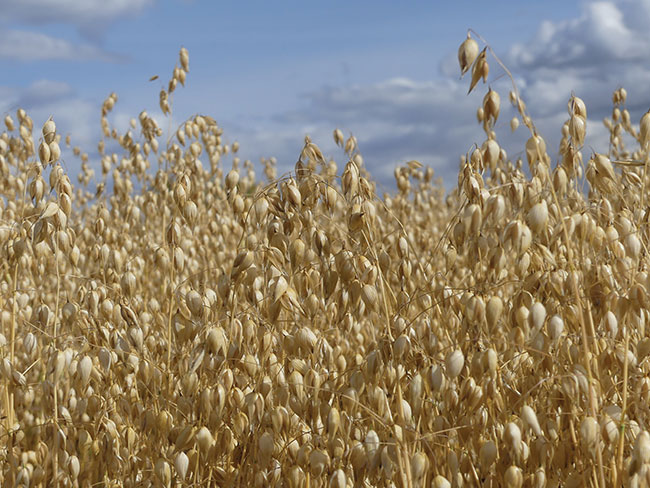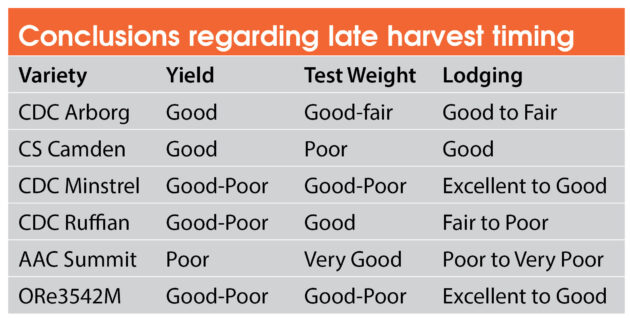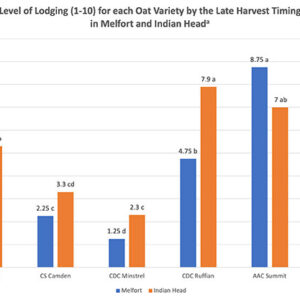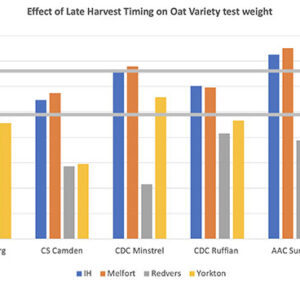
Features
Cereals
Weathering the weather
When the going gets tough, which oat variety toughs it out?
March 29, 2023 By Bruce Barker
 No one variety had the best characteristics to resist weathering.
Photo by Bruce Barker.
No one variety had the best characteristics to resist weathering.
Photo by Bruce Barker. Oat growers can be challenged to achieve milling quality because of harvest delays and field variability that impact grain quality and test weight. Timely harvest is key, but the longer the crop has to stand in the fall, the greater the chance for lodging, shattering and deterioration of grain quality.
“The lack of preharvest glyphosate can cause harvest management issues for producers with variable fields,” says Mike Hall, research coordinator with the East Central Research Foundation (ECRF) and Parkland College at Yorkton, Sask. “There are other practices that may help with field maturity, but many of them have a downside.”
Heather Sorestad, research assistant with ECRF and Parkland College says, “Swathing is an option but it also has a weathering risk. In many cases, field variability forces many producers to leave their oats standing in the field for longer, creating a greater risk for poor grain quality and higher grain loss.”
To address these issues, Hall and Sorestad developed a study in cooperation with Saskatchewan Oat Development Commission, which was conducted in 2021 and funded by Saskatchewan Ministry’s Ag Demonstration of Practices and Technologies (ADOPT) program. It was carried out at Yorkton, and other Agri-Arm sites at Indian Head, Melfort and Redvers.
The objective was to help producers select milling oat varieties that were more likely to maintain yield and grain quality when harvested late. Lodging, shatter loss, grain quality and yield were compared for six commonly grown milling oats that were harvested at ideal and late harvest timings. The oat varieties grown were CDC Arborg, CS Camden, CDC Minstrel, CDC Ruffian, AAC Summit and ORe3542M.
Trials were seeded between May 3 and May 12. Harvest timing considered “ideal” occurred when grain moisture was 12.5 to 13.5 per cent. The “late season” harvest timing occurred 19 to 29 days later depending on location.
Late harvest generally had lower yield
Overall, yields were generally low in 2021 due to low growing season precipitation. Yorkton, for example, had an average yield across all varieties of 61 bushels per acre for the ideal harvest timing on Aug. 11, and 68 bu/ac for the late timing. The harvest dates were much earlier than planned because the crop was quickly ripening due to the drought.
“To our surprise, the yield for the late harvest was significantly higher than the early harvest at Yorkton,” says Hall. “A couple things might explain this. First, the late harvest is not that late and
shelling hadn’t become a concern. Second, there may have been more seed filling in the immature secondary tillers, which often form when drought is followed by late season rainfall.”
At the other sites, overall oat yields were significantly lower when delaying crop harvest at Redvers, (-23.6 per cent), Indian Head (-25.6 per cent) and Melfort (-20.6 per cent) when compared to the early harvest date. Shelling and lodging were issues at Indian Head and Melfort.
At Indian Head, there was a significant harvest date by variety interaction, as the magnitude of yield loss from harvesting late differed between varieties. When harvested late, CDC Arborg and CS Camden lost less yield, approximately 16 bu/ac, compared to a yield loss ranging from 24 to 32 bu/ac for the other varieties. While significant interactions were not detected at Melfort or Redvers, CDC Arborg and CS Camden also maintained yield relatively well at these locations. The implication is that these varieties suffered less yield loss to lodging or shelling with late harvest

Lodging varied by variety and location
When harvested at the ideal timing, none of the varieties suffered any substantial lodging at any of the locations. By late harvest, lodging had increased substantially for some of the varieties at Indian Head and Melfort. AAC Summit suffered severe lodging at both locations. Lodging was also severe for CDC Ruffian at Indian Head and moderate at Melfort.
“These results are consistent with regional information” says Hall. “Lodging resistance of these varieties is rated as only ‘good’ compared to ‘very good’ for the other varieties.”
Lodging rates were on a scale of one to 10 with 10 being completely flat to the ground.
Test weight varied
Grain millers prefer oats with a test weight above 245 g/0.5 litre. Below this level, price discounts can be applied, and the sample is generally rejected below 230 g/0.5l.
Overall, test weights were relatively high at Indian Head averaging 243 g/0.5l and Melfort averaging 245 g/0.5l across all varieties and harvest timings. These levels were acceptable for milling. Test weights were much lower at Yorkton at 230 g/0.5l and Redvers at 211 g/0.5l.
The impact of late harvest on varietal test weight was inconsistent between locations. At Indian Head, CDC Arborg and CDC Minstrel had significantly higher test weights when harvested late, but test weights did not significantly differ between harvest timings for the rest of the varieties.
At Melfort, large reductions in test weight were observed for every variety when harvested late. At Yorkton, a large and significant increase in test weight occurred only with CS Camden when harvest date was delayed. At Redvers, late harvest test weights were only significantly lower for CDC Minstrel and ORE3542M.
It is unclear what is causing test weights to move up or down with late harvest. However, other studies have shown that CS Camden usually has the lowest test weight and AAC Summit frequently has the highest test weight. Despite low test weights, Hall says CS Camden is rarely rejected by oat millers and has been a popular variety with producers.
“This had me scratching my head, as we have frequently seen cases where the test weight of CS Camden has been cause for concern,” says Hall. “But, it has been suggested to me that producers may be blowing more light seed out the back of the combine than we do with our experimental plots. This may be helping producers to keep their test weights higher than what we find from research plots.”
Overall, Hall says there was variability between location, variety and harvest date, and no variety had the best yield, test weight and lodging resistance when harvested late. Based on the demonstration, he ranked each variety according to attribute.
CDC Arborg was a fairly solid variety. It had a good yield that resisted loss when harvest was delayed. It maintained a test weight in the middle pack and had good to fair resistance to lodging when harvested late, says Hall.
CS Camden showed good resistance to yield loss and lodging, and despite consistently having low test weights in our studies, this doesn’t seem to be causing rejection issues at oat millers. “This is probably why many producers are growing this variety,” says Hall.
CDC Minstrel demonstrated excellent-to-good resistance to lodging when harvested late. However, its relative yield and test weight were variable ranging from good to poor.
CDC Ruffian had fair-to-poor resistance to lodging when harvest was delayed. Its yield potential varied widely from good to poor, but its test weight was generally good.
AAC Summit had very good test weights. Unfortunately, its lodging could be poor to very poor when harvested late, and yields were often relatively poor, says Hall.
ORE3542M had excellent-to-good lodging resistance when harvested late, but its yield and test weight could be quite variable from good to poor.
“No variety had the best of all attributes, so if test weights have not been an issue for you, then keep growing CS Camden. If they have, consider another variety,” says Hall. “But, if lodging has been an issue for you then stay away from CDC Ruffian and AAC Summit, and maybe give CDC Arborg a try.”

